#API-based humanity
Explore tagged Tumblr posts
Text
“Becoming Nobody: An Engineering Blueprint for Recursive Self-Erasure Through Metaphysical Re-indexing”
ABSTRACT This paper explores the systematic deconstruction and reinvention of selfhood as a recursive engineering process. Inspired by popular cultural artifacts such as Mr. Robot and Fight Club, we examine the metaphysical implications of digital existence, online persona dissolution, and fact-finding automation as acts of resistance and transcendence. We treat identity as a computational…
#abstract scripting#AI consciousness spoofing#AI existentialism#AI Identity#AI reality shaders#AI-assisted identity design#algorithmic identity#algorithmic selfhood#algorithmic storytelling#anonymity scripts#anonymous indexing#anonymous presence#anti-branding tactics#API consciousness#API-based humanity#auto-generative narrative#auto-indexing identity#auto-replication scripts#automated research#automated self-inquiry#autonomous fiction#autonomy engine#behavioral data spoofing#behavioral proxies#cloud consciousness#code-based self#coded selfhood#cognitive dissociation#conceptual automation#content-driven persona
0 notes
Text

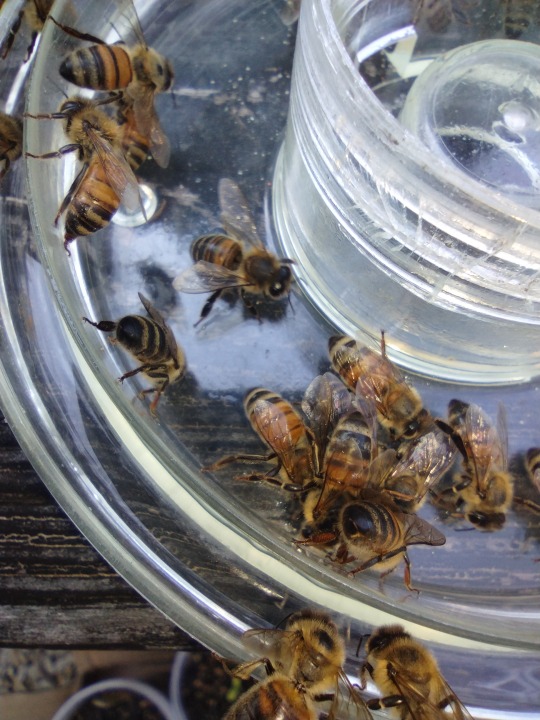
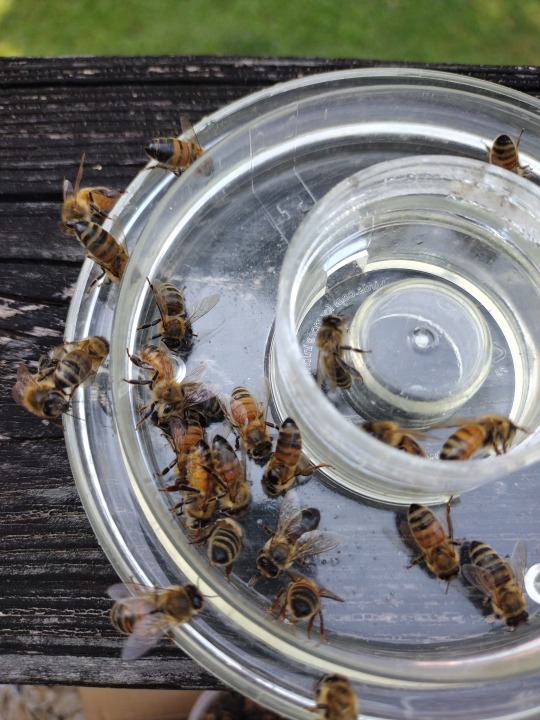
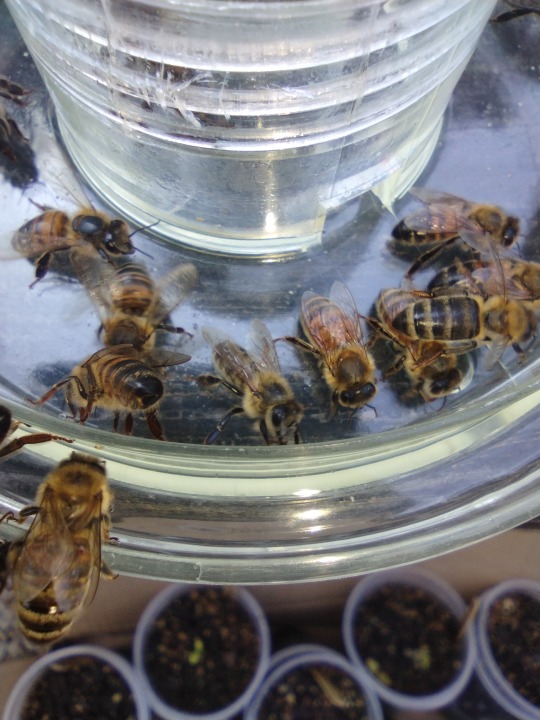


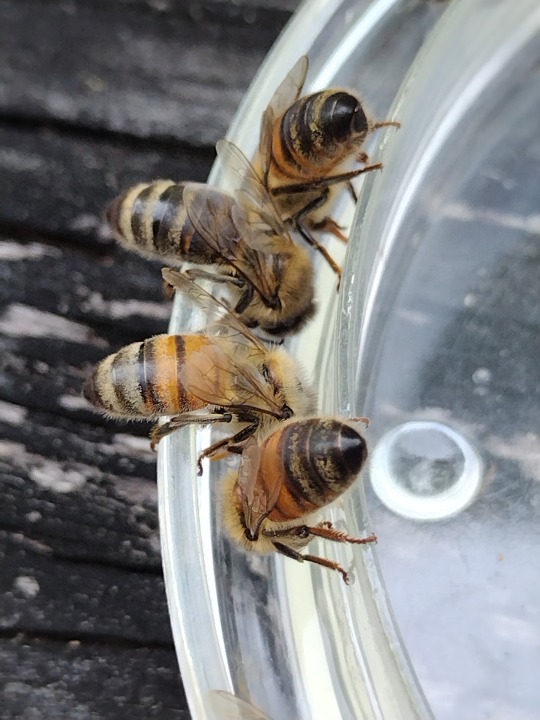

[VIDEO AND PHOTOS TAKEN: MAY 23RD, 2025 | Video and Image IDs: A video and eight photos of a swarm of orange, brown, and black western honey bees licking up what remains of the sugar water on a disassembled hummingbird feeder. The images mostly focus on the clear base, which is sitting atop a bit of grey wooden railing. In the video, the clear piece, still being licked relentlessly by some dedicated bees, is being held by a human hand, the camera turning to show how many are swarming around, as well as showing the other translucent red piece, with bits of tape attached to it /End IDs.]
An absolute ton of western honey bees (Apis mellifera)! Equally as polite as they are ravenous, as could be said of any Hymenopteran swarm when they realize you're the food provider—I've even had yellowjackets behave similarly when it comes to the mighty hummingbird feeder, but this is the biggest feeding frenzy I've ever seen!
Also, if you're wondering why the red piece has duct tape over it like that, I was testing a quick and easy way to replace the little flower hole covers on the feeder (after ensuring the tape was no longer sticky enough for any creature to get stuck to it). The previous covers had broken and tons of honey bees got stuck in it, as the hole was big enough to fit them and other similarly sized Hymenopterans. Which, I'll have to retest sometime (Or, y'know, just purchase a new feeder) because on this test I made the error of leaving the center open without realizing things could get through, which is why it's disassembled here.
#apidae#bees#bee#hymenoptera#insects#insect#bug#bugs#bugblr#arthropods#entomology#inverts#invertebrates#photos#photo#Wasp House Sights#honey bees#videos#video
73 notes
·
View notes
Text
The human body is widely know to be cringe and pathetic
The Machine with it's lack of self regulation, healing and overall inflexibility isn't much better, if not worse
Undeath is a no-go too since having the weakness of getting BTFOed by a catholic wavibg some sticks and spraying you with water is just too embarrassing
Porcelain is a meme I'm not even going to humor
Digital Construct sucks too not just because of software rot and server vulnerability but what if some twat pushes a test build of an API out on a friday and oops! you have no object permanence for a few days!
Energy-based thoughtform seems to be the only viable way to go
73 notes
·
View notes
Photo

A Brief History of Egyptian Art
Art is an essential aspect of any civilization. Once the basic human needs have been taken care of such as food, shelter, some form of community law, and a religious belief, cultures begin producing artwork, and often all of these developments occur more or less simultaneously. This process began in the Predynastic Period in Egypt (c. 6000 - c. 3150 BCE) through images of animals, human beings, and supernatural figures inscribed on rock walls. These early images were crude in comparison to later developments but still express an important value of Egyptian cultural consciousness: balance.
Egyptian society was based on the concept of harmony known as ma'at which had come into being at the dawn of creation and sustained the universe. All Egyptian art is based on perfect balance because it reflects the ideal world of the gods. The same way these gods provided all good gifts for humanity, so the artwork was imagined and created to provide a use. Egyptian art was always first and foremost functional. No matter how beautifully a statue may have been crafted, its purpose was to serve as a home for a spirit or a god. An amulet would have been designed to be attractive but aesthetic beauty was not the driving force in its creation, protection was. Tomb paintings, temple tableaus, home and palace gardens all were created so that their form suited an important function and, in many cases, this function was a reminder of the eternal nature of life and the value of personal and communal stability.
Early Dynastic Period Art
The value of balance, expressed as symmetry, infused Egyptian art from the earliest times. The rock art from the Predynastic Period establishes this value which is fully developed and realized in the Early Dynastic Period of Egypt (c. 3150 - c. 2613 BCE). Art from this period reaches its height in the work known as The Narmer Palette (c. 3200-3000 BCE) which was created to celebrate the unity of Upper and Lower Egypt under King Narmer (c. 3150 BCE). Through a series of engravings on a siltstone slab, shaped as a chevron shield, the story is told of the great king's victory over his enemies and how the gods encouraged and approved his actions. Although some of the images of the palette are difficult to interpret, the story of unification and the celebration of the king is quite clear.
On the front, Narmer is associated with the divine strength of the bull (possibly the Apis Bull) and is seen wearing the crown of Upper and Lower Egypt in a triumphal procession. Below him, two men wrestle with entwined beasts which are often interpreted as representing Upper and Lower Egypt (though this view is contested and there seems no justification for it). The reverse side shows the king's victory over his enemies while the gods look on approvingly. All these scenes are carved in low-raised relief with incredible skill.
This technique would be used quite effectively toward the end of the Early Dynastic Period by the architect Imhotep (c. 2667-2600 BCE) in designing the pyramid complex of King Djoser (c. 2670 BCE). Images of lotus flowers, papyrus plants, and the djed symbol are intricately worked into the architecture of the buildings in both high and low relief. By this time the sculptors had also mastered the art of working in stone to created three-dimensional life-sized statues. The statue of Djoser is among the greatest works of art from this period.
Continue reading...
124 notes
·
View notes
Text
using LLMs to control a game character's dialogue seems an obvious use for the technology. and indeed people have tried, for example nVidia made a demo where the player interacts with AI-voiced NPCs:
youtube
this looks bad, right? like idk about you but I am not raring to play a game with LLM bots instead of human-scripted characters. they don't seem to have anything interesting to say that a normal NPC wouldn't, and the acting is super wooden.
so, the attempts to do this so far that I've seen have some pretty obvious faults:
relying on external API calls to process the data (expensive!)
presumably relying on generic 'you are xyz' prompt engineering to try to get a model to respond 'in character', resulting in bland, flavourless output
limited connection between game state and model state (you would need to translate the relevant game state into a text prompt)
responding to freeform input, models may not be very good at staying 'in character', with the default 'chatbot' persona emerging unexpectedly. or they might just make uncreative choices in general.
AI voice generation, while it's moved very fast in the last couple years, is still very poor at 'acting', producing very flat, emotionless performances, or uncanny mismatches of tone, inflection, etc.
although the model may generate contextually appropriate dialogue, it is difficult to link that back to the behaviour of characters in game
so how could we do better?
the first one could be solved by running LLMs locally on the user's hardware. that has some obvious drawbacks: running on the user's GPU means the LLM is competing with the game's graphics, meaning both must be more limited. ideally you would spread the LLM processing over multiple frames, but you still are limited by available VRAM, which is contested by the game's texture data and so on, and LLMs are very thirsty for VRAM. still, imo this is way more promising than having to talk to the internet and pay for compute time to get your NPC's dialogue lmao
second one might be improved by using a tool like control vectors to more granularly and consistently shape the tone of the output. I heard about this technique today (thanks @cherrvak)
third one is an interesting challenge - but perhaps a control-vector approach could also be relevant here? if you could figure out how a description of some relevant piece of game state affects the processing of the model, you could then apply that as a control vector when generating output. so the bridge between the game state and the LLM would be a set of weights for control vectors that are applied during generation.
this one is probably something where finetuning the model, and using control vectors to maintain a consistent 'pressure' to act a certain way even as the context window gets longer, could help a lot.
probably the vocal performance problem will improve in the next generation of voice generators, I'm certainly not solving it. a purely text-based game would avoid the problem entirely of course.
this one is tricky. perhaps the model could be taught to generate a description of a plan or intention, but linking that back to commands to perform by traditional agentic game 'AI' is not trivial. ideally, if there are various high-level commands that a game character might want to perform (like 'navigate to a specific location' or 'target an enemy') that are usually selected using some other kind of algorithm like weighted utilities, you could train the model to generate tokens that correspond to those actions and then feed them back in to the 'bot' side? I'm sure people have tried this kind of thing in robotics. you could just have the LLM stuff go 'one way', and rely on traditional game AI for everything besides dialogue, but it would be interesting to complete that feedback loop.
I doubt I'll be using this anytime soon (models are just too demanding to run on anything but a high-end PC, which is too niche, and I'll need to spend time playing with these models to determine if these ideas are even feasible), but maybe something to come back to in the future. first step is to figure out how to drive the control-vector thing locally.
48 notes
·
View notes
Text

⭐️
Author: DancingFey
Group C: secret admirer; let’s get away; bees, honey
⭐️
The Bee's a Bookworm
“Snakeweed for the base, fennel for strength, garlic for protection…” Rumplestilkin hummed as he dropped each ingredient into a pot of boiling water. “Three out of four is not complete! Tell me, which ingredient do I seek?”
His question was answered by his uninvited guest buzzing in his ear.
When they first arrived at the Dark Castle, he refused to break their curse without a deal. The fact that they couldn’t communicate was not his problem. He expected them to leave, but the little bug stayed even after multiple threats of shoe stomping.
He took a moment to replace his spinner’s smile with an impish smirk before turning around to face the Apis Mellifera that had been haunting his castle.
The bee hovered inches from his face.
“Well! Li’l bee, since you refuse to leave, you may as well make yourself useful.”
The honeybee flew in his face, ruffling his bangs before flying off towards his cabinet of herbs, landing on a jar.
“Testy today, dearie?” He grumbled before fluffing his hair back into place and walking over.
“Ah-ha! Thyme, of course!” He grabbed the jar and returned to the brewing potion. “How could I forget the herb for bravery in a Bravery Potion!”
Rumple extended his index finger, and the honeybee jumped from the jar onto his scaly hand without hesitation. He set the bee on his shoulder, where they would sit and observe as he worked. Not that it stopped them from flying down anytime he brought out a book.
At first, he had considered killing them, but on the fourth day, the honeybee found a passage that he had spent weeks searching for in an old botanist’s journal containing theories of how feyberry and dreamweave vines may react when dissolved with unicorn blood. Then, the bloody thing had to go and wiggle their butt high in the air, hop side to side, spin around, and perform an aerial backflip in what Bae would have called a victory dance. It reminded him so much of his son that his heart clenched at the sight.
That was the moment he knew he couldn’t kill the damn bee.
It became routine for the cursed bee to assist him in his research. They would point to paragraphs that contained the information he was looking for. And if he missed something from a previous passage, they directed him to the chapter by nestling their body between the pages, wiggling their black-striped backside to push their body underneath.
He refused to acknowledge how cute they were or that he was rapidly lowering his defenses around them.
As he finished the Bravery Potion, a white dove tapped on his window. “Dove! Good, you're back! I have a use for you.”
Rumple opened the window, and the shapeshifter transformed with a plume of grey smoke into a bald, scarred, muscular man.
“I did not expect you to take in another pet, master.”
“Ha! One pet is more than enough work for me. No, you can give me your report on your mission later. For now, I need you to translate. You see, this poor, helpless creature is cursed! And only I can break it. But alas, a deal must be struck!”
Dove stared at his master’s antics and sighed. “And what are your terms of the contract, master Rumpelstiltskin?”
“Hmm, well the little bugger has been surprisingly…helpful. I will break their curse, returning them to their human form. In return, they will stay in the Dark Castle with me, and work as my research assistant for…oh, say five years.”
A contract appeared on the table at the wave of his hand, and the bee instantly flew down to read it. Once finished, Dove translated their response.
“They will agree to your terms if you make an amendment. They want to be allowed to write home with the concession that you can read and approve the letters beforehand.”
“Fine, but remember dearie, no one breaks a deal with me.”
He swore the bee rolled their eyes at him before dipping their forelegs in ink and signing the contract.
“It’s a deal!” He giggled before black, purple-tinted magic consumed the bee, leaving a beautiful young woman sitting on his desk with chestnut curls and eyes so blue they were like the reflection of light on the ocean.
“Did it work?” She frantically patted down her blue dress, “It worked! Oh, thank you. Thank You!”
She jumped off the table and wrapped her arms around his neck. Rumple glanced at Dove for assistance, but he only raised an eyebrow and smirked—the bastard.
“Yes, yes, dearie.” He awkwardly patted her back, “We made a deal…and now…” His voice trilled, “The monster has you in its clutches!”
“You’re not a monster. You’re a scholar. The amount of knowledge you have is incredible! And your books! Some of those records have been lost for centuries. And you don’t keep them in some ostentatious display to collect dust. You use them. You’re…you’re a genius! I’ve seen you create potions and spells that no one has ever thought of!”
This woman was either a miracle or a hallucination. Rumplestiltskin was leaning more towards the drugs.
“Sounds like you have a secret admirer,” Dove nudged his shoulder. Rumple stared at him as if he’d also lost his mind, but the cretin only shrugged…and then left!
“I-Is it so hard to believe? For all your threats of squashing me, you never harmed me, and you’re so passionate about your work. How could I not admire someone so dedicated to their craft? I…I confess I have always dreamed of being a scholar. Perhaps this is not how I imagined it happening, but I am honored to be your research assistant.”
She took a deep breath and reached out her hand. “I never got the chance to introduce myself. My name is Belle.”
Rumple stared at her hand, confounded, but shook it, “I don’t believe I need any introductions, dearie?”
She laughed, “No, but now I can finally get you out of this room.”
“W-What?”
“You haven’t left this workshop at all since I got here! Not to eat, drink, or sleep. Heavens forbid, you step outside! Rumple, you need to take a break. Breathe fresh air. Feel the sun’s warmth on your skin. Come on, let’s get away from this lab.”
She grabbed his hand and led him outside. Stunned and still half convinced Belle was a hallucination, he followed. They walked until they passed through a thicket of trees that opened into a grove filled with wildflowers.
“Isn’t it beautiful?” She let go of his hand and twirled around the flowers as if she belonged among them.
Yes, you are. Rumple shook his head to stop such nonsensical thoughts.
“When I was a bee, I was drawn here by the flowers' scent. They smelled so sweet and rich, unlike anything I had ever experienced as a human, and the flowers had so many vibrant colors, some of which I had never seen before! I thought this would be a great place to get away and have a picnic.”
“Picnic?”
“Yes, you need to eat, and I haven’t had human food since my ex-fiancé’s mother cursed me.”
He would be asking her questions about that later.
“A picnic, my lady wants. A picnic she shall get.” He gave her a mock bow before a picnic blanket with various dishes appeared.
Belle looked to see what foods he had conjured, when her eyes widened, “Oh! Honey cakes…” She started laughing and looked at him expectantly, to which he only raised an eyebrow and tilted his head in a silent question. “Get it? ‘Bees, honey.’ Remember?”
His face lit up at the memory, and he sang in a high-pitched voice, “Bees, honey. Oh, how lovely! A guest has arrived! A guest has arrived! Oh, what scheme has she contrived for this bee…is surely a spy!”
“And then you caught me in a jar.”
“It’s not every day a cursed maiden flies into my workshop, honey. Odds were the Evil Queen sent you to spy on me.”
Wait, honey?! Where did that come from?!
“Yes, you were insistent in your interrogation, even though we couldn’t communicate,” Belle smiled.
“You won’t be smiling at me for long.” He pointed a clawed finger at her, “I plan to work you to the bone.”
“I’m looking forward to it.”
Who was this woman? She wasn’t afraid of him, which already made her part of a small minority, but then she dared to not only make a demand from him but physically make him obey! Not Dove, Regina, or even Jefferson would be that bold! They would at least worry he might take revenge, but she treated him like a normal man, not a monster. She acted as if she saw him as a…friend.
Hallucination or not, Rumpelstiltskin was never letting Belle go.
He smiled back, and with a flick of his wrist, a red rose appeared in his hand.
“A flower for my li’l bee.”
Belle took the rose with a bright smile and mischief sparkling in her eyes. “I’m not a bee anymore.” She leaned across the blanket and kissed his cheek, “I’m your little bookworm.”
26 notes
·
View notes
Text
grimm and yarrow- modification details
there were several points when typing out the humod info post that i started to veer into talking about the details of grimm and yarrow's specific modifications hence: this post
grimm
coyote (canis latrans) humod, modified at around ~13 years old for a few months. standardized modification with minor tweaks
visible physical features
fur- grows most prevalently under eyes and on sides of face, but also at the base of their spine (where their tail connects) and on their lower stomach
sharp claws on fingers- when left untrimmed, its nails will grow into claws. nails are tinted a slightly darker grey-black than normal, which is why it paints them black
minor hyperdontia- additional pair of canine teeth + single pair of small, sharp incisors on both upper and lower jaw
small tail- not developed to full length, but retains flexibility. grows organically from their spine
clawed + furred digits on right foot with some black paw pads as well. doesn't affect their gait
tapetum lucidum- eyes will reflect in proper lighting conditions- they can see better than average in the dark
other features/traits
body temperature runs higher than average- i need to check the facts on this but it may not get sick as often bc of this
sense of smell is most enhanced of all their senses, but their hearing and sight are slightly sharper than average
has an appetite for raw meat and can hold down more of it than an average person
can make some coyote vocalizations including yips, growls, barks, and whines
has an innate understanding of canine behaviors and can semi-communicate with most canine or canine-modified animals
additional info/funny tidbits
grimm goes to great lengths to hide all of its traits up until p3- very few people know it's humod before that. this includes almost always wearing socks and talking without moving their lips a lot
during p3 they only trim the nails on their left (dominant) hand and allow the ones on their right to grow into claws mostly for the sake of always having a weapon (literally) on-hand
is also not above full-on biting people, but will only do so in more extreme circumstances (or yarrow but that's. different.)
has chewing behavioral impulses but those are often curbed by its jaw issues
it's not visible given how unexpressive human ears are, but grimm will instinctively flex the muscles in/around their ears much like an actual coyote would
the short modification time + slightly unconventional modification is why their foot developed asymmetrically
has self-awareness of steel with its coyote behaviors and tamps them down unless it's alone (or later, with yarrow. see: tail wagging)
enjoys being scratched on its lower back at the base of its tail
yarrow
honeybee (apis mellifera) humod, modified at around ~31 years old for approximately a year
quick a/n abt yarrow: as much as i am a geek about anatomy and figuring out how things may be made semi-plausible, there are a few things going on with them that i look at from a more anatomical perspective and go "i'm not going to think too hard about how that's structured internally" after a certain point i prioritize what's fun to draw/play with and stop caring about 100% realism
visible physical features
just look at him
i'm kidding i'll actually talk about things
exoskeleton- sometimes put in quotes because it's made out of keratin and not chitin. encases his right arm, spine, right fingertips, collarbone area, and most of his neck
antennae- attach around his cheekbones and do receive sensory input that is VERY disorienting for him at first
eyes- additional eyes on their cheekbones and the medial end of their eyebrows. the eyesight on these is not as good as their primary eyes, but do expand yarrow's range of vision. don't have eyelids and instead have a sort of...semi-hard covering to protect them? their eyes cannot move in independent directions
black sclera- cosmetic trait but another thing that makes it so yarrow cannot hide being humod like grimm could
mandibles- in addition to retaining their upper and lower jaw, they have a pair of mandibles on each that can move independently of one another. bite force is comparable to a human jaw when moving independently of the jawbones itself
tongue- tongue can split down the middle to reveal a proboscis-like second tongue. the proboscis is hollow
wings- has a single pair of beelike wings on his upper back. these are too small to do anything other than flap, but he sometimes uses it to help cool off
secondary arms- has a pair of insectoid smaller arms sprouting from his sides. they end in two fingers and no thumbs and can loosely grasp/hold things
other features/traits
he molts- it happens ~once a year if not at longer intervals but it's annoying and his skin feels weird and too tight for several days and then he can't fuck around with things too much before everything hardens or he risks having a deformity until his next molt. does have grimm press their thumb into the palm of his right hand to make an indent after every molt though
has some extra senses (sort of) due to his antennae- still working out what exactly but there's a smelltaste component to it as well as a barometric one
antennae are also VERY sensitive to touch and can easily cause sensory overload if manhandled
if they consume enough sugar, their saliva will start to taste like honey. incapable of producing actual honey
difficult to say if their behavior has been affected by their modification because yarrow has always been loyal and protective of their loved ones, might have amped that up a bit but also. the Circumstances
cannot communicate with bees but will attract their curiosity
additional info/funny tidbits
despite how drastic his modification looks, it's generally surface-level. for instance, his right arm is encased in keratinous exoskeleton but still retains most (if not all) of the underlying bone and muscle structure. his right hand went from having five to three digits, but still retains all the bones in there
their secondary arms don't have bones in them- when they're unconscious they curl up in a similar way to dead bug legs
the most heavily-changed part of them structure-wise is their face, where the underlying muscles have reformed to accommodate the bug mandibles in the zygomatic and mandibular regions. there's a little bit of bone rearranging there too but. waves my hand dismissively
his exoskeletal parts have drastically lower responsiveness to touch- does retain pressure sensitivity
the pinker parts of his exoskeleton are softer/more sensitive/more flexible
modification is "incomplete" hence the heavy asymmetry
he was not on testosterone while being modified, which is partially responsible for him expressing traits more similar to worker bees than drone bees (him resuming t afterwards doesn't affect much of his modification aside from small shifts such as a slight increase in antennae sensitivity)
often clicks his mandibles together as like. probably a stim thing. is about as irritating as someone clicking a pen
also likes poking/smelltasting grimm with their antennae
#finally! this post#also i hope this like. makes sense#things you can tell i have thought about perhaps too much but. i enjoy turning these types of things around in my head#i really really like anatomy type stuff from a scientific perspective but i haven't had any classroom-setting education abt it in like ten#years so will fully admit my knowledge is kinda touch-and-go. i try to brush up on things here and there though#also love love thinking about the nonphysical aspects of modification i'm having so much fun with this if you couldn't tell dhgklfd#my beloved ocs....keeping me afloat when my brain insists on veering off the road..............#honeybee#grimm#yarrow#also there is an Addition in the rbs if you are so inclined. gestures my hand vaguely
10 notes
·
View notes
Note
How do bees fly?
The classic Bee Movie line about their flight being scientifically impossible is based on an urban legend that science couldn't explain how they did. This was true at one time and became a common bit of trivia, though science has since explained the physics involved. The rumor persists owing mostly to religious apologetics and the aforementioned film.
But far more interesting is the contribution of that film to the world of bee-themed sexuality. Though sex between a human being and a bee being as depicted so graphically in the film is not possible owing to the size difference (the movie is animated for a reason), people can wear bee suits or body paint, and it has since become quite hip to fuck bees. So the question is not truly, "How do bees fly?" but "Why is bee sex so hot? Why is honey-slathered lovemaking so incredible? Why do we shoot pollen farther when aroused by someone dressed like an Apis milfera bug? Why is it so incontrovertibly the bees knees to grab their 6 fuzzy hips and go to town on a striped abdomen?"
This, we may simply never know.
93 notes
·
View notes
Text
GPT-4 Chatbot Tutorial: Build AI That Talks Like a Human
youtube
Ready to craft the most intelligent virtual assistant you've ever worked with? In this step-by-step tutorial, we're going to guide you through how to build a robust GPT-4 chatbot from scratch — no PhD or humongous tech stack needed. Whether you desire to craft a customer care agent, personal tutor, story-sharing friend, or business partner, this video takes you through each and every step of the process. Learn how to get started with the OpenAI GPT-4 API, prepare your development environment, and create smart, responsive chat interactions that are remarkably human. We'll also go over how to create memory, personalize tone, integrate real-time functionality, and publish your bot to the web or messaging platforms. At the conclusion of this guide, you'll have a working GPT-4 chatbot that can respond to context, reason logically, and evolve based on user input. If you’ve ever dreamed of creating your own intelligent assistant, this is your moment. Start building your own GPT-4 chatbot today and unlock the future of conversation.
For Business inquiries, please use the contact information below: 📩 Email: [email protected]
🔔 Want to stay ahead in AI and tech? Subscribe for powerful insights, smart tech reviews, mind-blowing AI trends, and amazing tech innovations! / @techaivision-f6p
===========================
✨ Subscribe to Next Level Leadership and empower your journey with real-world leadership and growth strategies! / @nextlevelleadership-f3f
🔔𝐃𝐨𝐧'𝐭 𝐟𝐨𝐫𝐠𝐞𝐭 𝐭𝐨 𝐬𝐮𝐛𝐬𝐜𝐫𝐢𝐛𝐞 𝐭𝐨 𝐨𝐮𝐫 𝐜𝐡𝐚𝐧𝐧𝐞𝐥 𝐟𝐨𝐫 𝐦𝐨𝐫𝐞 𝐮𝐩𝐝𝐚𝐭𝐞𝐬. / @techaivision-f6p
🔗 Stay Connected With Us. Facebook: / tech.ai.vision
📩 For business inquiries: [email protected]
=============================
#gpt4#gpt4chatbot#aichatbot#openai#chatbottutorial#aiassistant#chatgpt#artificialintelligence#machinelearning#apidevelopment#codingtutorial#virtualassistant#pythonprogramming#techtutorial#futureofai#Youtube
3 notes
·
View notes
Text
For years, hashing technology has made it possible for platforms to automatically detect known child sexual abuse materials (CSAM) to stop kids from being retraumatized online. However, rapidly detecting new or unknown CSAM remained a bigger challenge for platforms as new victims continued to be victimized. Now, AI may be ready to change that.
Today, a prominent child safety organization, Thorn, in partnership with a leading cloud-based AI solutions provider, Hive, announced the release of an API expanding access to an AI model designed to flag unknown CSAM. It's the earliest use of AI technology striving to expose unreported CSAM at scale.
An expansion of Thorn's CSAM detection tool, Safer, the AI feature uses "advanced machine learning (ML) classification models" to "detect new or previously unreported CSAM," generating a "risk score to make human decisions easier and faster."
The model was trained in part using data from the National Center for Missing and Exploited Children (NCMEC) CyberTipline, relying on real CSAM data to detect patterns in harmful images and videos. Once suspected CSAM is flagged, a human reviewer remains in the loop to ensure oversight. It could potentially be used to probe suspected CSAM rings proliferating online.
It could also, of course, make mistakes, but Kevin Guo, Hive's CEO, told Ars that extensive testing was conducted to reduce false positives or negatives substantially. While he wouldn't share stats, he said that platforms would not be interested in a tool where "99 out of a hundred things the tool is flagging aren't correct."
9 notes
·
View notes
Text
Excerpt from this story from the Union of Concerned Scientists:
The U.S. oil and gas industry has sounded its mating call to the incoming Presidential administration with a policy wish list remarkable for its unabated pursuit of profits and defiance of climate science and economic trends.
The American Petroleum Institute (API) released a “policy roadmap” addressed to President-elect Donald Trump on November 12 outlining five “actions” he can take to bolster their agenda. However, the “actions”—given euphemistic titles like “protect consumer choice”—actually aim to roll back science-based environmental protections in order to maximize already massive profits. The policy details within each action roughly correspond with recommendations in Project 2025, the infamous policy agenda penned in part by figures from the first Trump administration and supported by several anti-climate organizations.
Here’s a breakdown of the roadmap’s requests along with an explanation of how they would roll back environmental progress.
API’s anti-environment entreaties
Fight clean cars. API’s first policy proposal is repealing rules designed to support the shift to electric vehicles that the oil and gas industry has fought for decades. API specifically targets Environmental Protection Agency (EPA) rules to reduce carbon emissions from automobile tailpipes and fuel economy standards established by the National Highway Traffic Safety Administration. API also targets an EPA waiver for a 2022 California rule that would reduce pollution from new gasoline-powered cars while increasing sales requirements for zero-emission vehicles.
Pump up gas. The second policy proposal is to reinstate permitting of liquified natural gas (LNG), also known as methane, a fossil fuel that is a potent source of global warming emissions. The Biden administration temporarily paused pending approvals for new LNG export authorizations in January 2024, citing the need to update the review process to best reflect impacts on climate, domestic energy prices, and health—especially as borne by frontline communities.
Reverse protections for public land and health. The third policy proposal focuses on federal lands that API believes should be opened up to drilling, both onshore and offshore. It recommends repealing a Bureau of Land Management rule that would put conservation on equal footing with drilling and ranching as a legal use of public lands, in addition to adding more leasing opportunities from the Bureau of Ocean Energy Management’s offshore leasing program. But the most blatantly anti-climate demand in this area would repeal a Congressionally approved fee on every metric ton of methane that high-emitting oil and gas facilities produce above specific levels. The oil and gas industry is responsible for 30 percent of human-caused methane emissions.
Muzzle environmental reviews. The fourth policy proposal involves the federal permitting process, a perennial enemy of the fossil fuel industry. The statute in their crosshairs is the National Environmental Protection Act (NEPA), which the industry has fought since it was signed into law by Republican President Richard Nixon in the 1970s. API and Project 2025 sing from the same sheet in their NEPA-related demands, which would curtail scientific and environmental reviews, limit public notice and comment, and block access to the courts.
Preserve industry giveaways. API finishes off its wish list with requests to preserve fossil fuel industry tax breaks that cost taxpayers some $3 billion each year, regardless of how much they’re currently paying at the pump.
6 notes
·
View notes
Text
“Becoming Nobody: An Engineering Blueprint for Recursive Self-Erasure Through Metaphysical Re-indexing”
ABSTRACT This paper explores the systematic deconstruction and reinvention of selfhood as a recursive engineering process. Inspired by popular cultural artifacts such as Mr. Robot and Fight Club, we examine the metaphysical implications of digital existence, online persona dissolution, and fact-finding automation as acts of resistance and transcendence. We treat identity as a computational…
#abstract scripting#AI consciousness spoofing#AI existentialism#AI Identity#AI reality shaders#AI-assisted identity design#algorithmic identity#algorithmic selfhood#algorithmic storytelling#anonymity scripts#anonymous indexing#anonymous presence#anti-branding tactics#API consciousness#API-based humanity#auto-generative narrative#auto-indexing identity#auto-replication scripts#automated research#automated self-inquiry#autonomous fiction#autonomy engine#behavioral data spoofing#behavioral proxies#cloud consciousness#code-based self#coded selfhood#cognitive dissociation#conceptual automation#content-driven persona
0 notes
Text
What is ChatGPT AI?
ChatGPT AI is a powerful language model developed by OpenAI that allows users to have human-like conversations with artificial intelligence. Based on the GPT (Generative Pre-trained Transformer) architecture, ChatGPT uses advanced deep learning techniques to understand and generate natural language text. It has become one of the most popular AI tools on the internet, known for its ability to write essays, answer questions, summarize content, translate languages, code software, and more — all in real time.
ChatGPT has evolved through various versions, beginning with GPT-2 and GPT-3, and now the latest advancements include GPT-4 and GPT-4o. These models have billions of parameters, enabling them to understand context, tone, and even emotions in text. The ChatGPT AI is designed to serve multiple purposes such as education, content creation, customer support, personal assistance, and entertainment.
One of the key features of ChatGPT is its accessibility. The ChatGPT website allows users to sign up for free and start using its basic version. This ChatGPT free access provides an excellent opportunity for students, writers, and professionals to explore AI capabilities without cost. For users who need more features, faster responses, and access to the most powerful models, ChatGPT Plus is available for a subscription fee. This premium version unlocks GPT-4 and enhanced performance.
Many users search for ChatGPT unlimited free versions to bypass limitations, though it’s important to use it within the official platforms to ensure safety and quality. While some platforms falsely promote ChatGBT, ChatGTP, ChatGBT AI, or Chat GBT, these are often typos or imitations of the original ChatGPT tool by OpenAI. It is always recommended to access the official ChatGPT website for genuine services.
What makes ChatGPT AI stand out is its ability to continuously learn from vast datasets and provide relevant, creative, and accurate outputs. Whether you’re chatting casually with Chat GPT, using it to brainstorm ideas, or getting help with complex subjects like coding or science, its utility is unmatched. With the rising demand for AI in day-to-day life, tools like ChatGPT online are setting new standards for how people interact with machines.
Another strong point of Chat AI GPT is its multi-platform availability. It can be used through the web, mobile apps, and API integrations, making it highly versatile. It supports multiple languages and continues to improve based on user feedback and updates from OpenAI.
In conclusion, ChatGPT AI is more than just a chatbot. It’s a revolutionary tool changing the way humans communicate with technology. Whether referred to as Chat GPT, ChatGBT, ChatGTP, or ChatGPT AI, it represents the future of interactive artificial intelligence. As AI continues to grow, ChatGPT is leading the way in making intelligent conversation accessible to everyone across the globe.
2 notes
·
View notes
Text
Traditional Vs Automated Direct Mail Services
Direct mail has long been a trusted marketing channel. In 2025, businesses face a choice between traditional direct mail services and automated solutions. Understanding the difference can drastically impact your campaign’s efficiency, ROI, and customer experience.

What Is Traditional Direct Mail?
Traditional direct mail involves manual processes such as:
Designing postcards or letters by hand or through desktop software
Printing at local shops or internal print facilities
Manually stuffing, stamping, and mailing
Tracking via physical receipts or third-party couriers
Pros:
Full control over the process
Hands-on personalization
Local vendor relationships
Cons:
Time-consuming
Prone to human error
Hard to scale
Costlier for small volumes
What Is Automated Direct Mail?
Automated direct mail refers to using software or APIs to trigger, personalize, print, and send mail pieces based on digital actions or CRM data.
Examples:
A new customer signs up, and a welcome postcard is triggered automatically
Abandoned cart triggers a mailed coupon
Real-time API sends birthday cards based on database date
Pros:
Scalable for millions of mailings
Real-time integration with CRMs and marketing platforms
Consistent branding and quality
Analytics and tracking included
Cons:
Higher setup cost initially
Requires data hygiene and tech alignment
Key Differences Between Traditional and Automated Direct Mail
FeatureTraditionalAutomatedSpeedSlow (days to weeks)Instant or scheduledScalabilityLimitedHighly scalablePersonalizationManualDynamic via variable dataTrackingManual or nonexistentDigital trackingIntegrationNoneAPI and CRM support
When Should You Choose Traditional?
For small, one-time mailings
When personal touch matters (e.g., handwritten letters)
In areas with no access to digital tools
When to Use Automated Direct Mail?
For ongoing marketing campaigns
When speed, consistency, and tracking are priorities
For eCommerce, SaaS, healthcare, insurance, and real estate
Use Case Comparisons
Traditional Use Case: Local Real Estate Agent
Manually prints and mails just listed postcards to a zip code every month.
Automated Use Case: National Insurance Company
Triggers annual policy renewal letters for 500,000+ customers via API.
Benefits of Automation in 2025
Real-Time Triggers from websites, CRMs, or payment systems
Enhanced Reporting for ROI measurement
Reduced Costs with bulk printing partnerships
Faster Delivery using localized printing partners globally
Eco-Friendly Workflows (less waste, digital proofing)
How to Switch from Traditional to Automated Direct Mail
Audit your current workflow
Choose a provider with API integration (e.g., PostGrid, Lob, Inkit)
Migrate your address data and test campaigns
Train your team and build trigger-based workflows
Conclusion: Choosing the Right Direct Mail Method
Ultimately, the right choice depends on your goals. While traditional direct mail has its place, automated direct mail offers speed, flexibility, and scale. For modern businesses aiming for growth and efficiency, automation is the clear winner.
SEO Keywords: traditional vs automated direct mail, automated mailing services, direct mail automation, API for direct mail, manual vs automated marketing.
youtube
SITES WE SUPPORT
Healthcare Mailing API – Wix
2 notes
·
View notes
Text
AI Code Generators: Revolutionizing Software Development
The way we write code is evolving. Thanks to advancements in artificial intelligence, developers now have tools that can generate entire code snippets, functions, or even applications. These tools are known as AI code generators, and they’re transforming how software is built, tested, and deployed.
In this article, we’ll explore AI code generators, how they work, their benefits and limitations, and the best tools available today.
What Are AI Code Generators?
AI code generators are tools powered by machine learning models (like OpenAI's GPT, Meta’s Code Llama, or Google’s Gemini) that can automatically write, complete, or refactor code based on natural language instructions or existing code context.
Instead of manually writing every line, developers can describe what they want in plain English, and the AI tool translates that into functional code.
How AI Code Generators Work
These generators are built on large language models (LLMs) trained on massive datasets of public code from platforms like GitHub, Stack Overflow, and documentation. The AI learns:
Programming syntax
Common patterns
Best practices
Contextual meaning of user input
By processing this data, the generator can predict and output relevant code based on your prompt.
Benefits of AI Code Generators
1. Faster Development
Developers can skip repetitive tasks and boilerplate code, allowing them to focus on core logic and architecture.
2. Increased Productivity
With AI handling suggestions and autocompletions, teams can ship code faster and meet tight deadlines.
3. Fewer Errors
Many generators follow best practices, which helps reduce syntax errors and improve code quality.
4. Learning Support
AI tools can help junior developers understand new languages, patterns, and libraries.
5. Cross-language Support
Most tools support multiple programming languages like Python, JavaScript, Go, Java, and TypeScript.
Popular AI Code Generators
Tool
Highlights
GitHub Copilot
Powered by OpenAI Codex, integrates with VSCode and JetBrains IDEs
Amazon CodeWhisperer
AWS-native tool for generating and securing code
Tabnine
Predictive coding with local + cloud support
Replit Ghostwriter
Ideal for building full-stack web apps in the browser
Codeium
Free and fast with multi-language support
Keploy
AI-powered test case and stub generator for APIs and microservices
Use Cases for AI Code Generators
Writing functions or modules quickly
Auto-generating unit and integration tests
Refactoring legacy code
Building MVPs with minimal manual effort
Converting code between languages
Documenting code automatically
Example: Generate a Function in Python
Prompt: "Write a function to check if a number is prime"
AI Output:
python
CopyEdit
def is_prime(n):
if n <= 1:
return False
for i in range(2, int(n**0.5) + 1):
if n % i == 0:
return False
return True
In seconds, the generator creates a clean, functional block of code that can be tested and deployed.
Challenges and Limitations
Security Risks: Generated code may include unsafe patterns or vulnerabilities.
Bias in Training Data: AI can replicate errors or outdated practices present in its training set.
Over-reliance: Developers might accept code without fully understanding it.
Limited Context: Tools may struggle with highly complex or domain-specific tasks.
AI Code Generators vs Human Developers
AI is not here to replace developers—it’s here to empower them. Think of these tools as intelligent assistants that handle the grunt work, while you focus on decision-making, optimization, and architecture.
Human oversight is still critical for:
Validating output
Ensuring maintainability
Writing business logic
Securing and testing code
AI for Test Case Generation
Tools like Keploy go beyond code generation. Keploy can:
Auto-generate test cases and mocks from real API traffic
Ensure over 90% test coverage
Speed up testing for microservices, saving hours of QA time
Keploy bridges the gap between coding and testing—making your CI/CD pipeline faster and more reliable.
Final Thoughts
AI code generators are changing how modern development works. They help save time, reduce bugs, and boost developer efficiency. While not a replacement for skilled engineers, they are powerful tools in any dev toolkit.
The future of software development will be a blend of human creativity and AI-powered automation. If you're not already using AI tools in your workflow, now is the time to explore. Want to test your APIs using AI-generated test cases? Try Keploy and accelerate your development process with confidence.
2 notes
·
View notes
Text
Blog 10: Overpriced Jackets and Underrated Poems
London Markets and street culture
The London markets are not exactly what I was expecting…though, to be fair, I’m not sure what I was expecting. It felt like a huge, permanent flea market. Shops and eateries lined the streets, with even some street performers sprinkled in for atmosphere.

The shops were fascinating because they ranged from antiques to retro clothing to books to brand-new items, and even some handmade originals. The Notting Hill shops (Portobello Road) ended up being some of my favorites. Our API guide offered to take anyone interested there on one of our free days, and a group of us took her up on it; partly because she knew the way, and partly because phone data wasn’t always reliable.
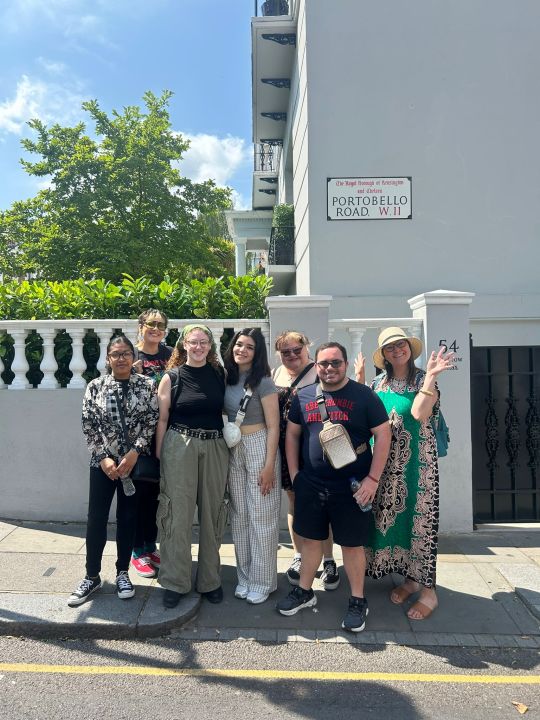
When we got there, I realized the shops were only a small part of the experience. The buildings, the homes, even the graffiti on the walls of the market— all of it seemed to be part of a larger story. My favorite was a mural of eyes above a shop. I couldn’t stop thinking about the detail that went into those eyes. Whose eyes were they? They looked old and wise, almost like they had seen the entire history of the market. And maybe I’m reading too much into it, but they reminded me of my grandfather. Like my own guardian, who watches over me and protects me. Maybe these were the eyes of the market’s grandfather, silently guarding the place. Or maybe I’m just getting sentimental and overanalyzing everything… but then again, I wouldn’t be an English major if I didn’t.

I quickly came to understand, though, that not all markets are created equal. Some, like Camden Market and Borough Market, were… not as original. Sure, they had shops and food, but the small stalls that lined the streets were full of knockoffs. Bad ones, at that. And the prices? Let’s just say they didn’t exactly scream “street vendor,” they were closer to a high-end boutique.

While walking through Camden, a friend of mine, Justin, was checking out jackets. He found one he really liked and was about to buy it, that is until the vendor told him it would set him back nearly seventy pounds (about $95). For a fake jacket! It blew my mind. I thought these markets were supposed to be cheap. Maybe they’re just cleverly disguised tourist traps where locals make their living.
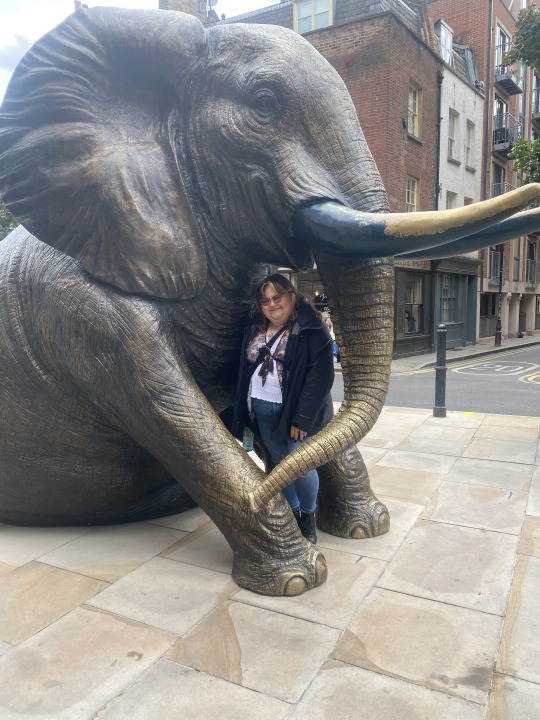
Still, the street life all around London was just as lively as the marketplaces. One day, while walking in front of the National Gallery, I came across a man sitting with an old typewriter and a small cardboard sign that read: “Pay What You Want for a Poem.” Naturally, I had to take him up on it. I was broke, I love poetry, and it felt like a once-in-a-very-London opportunity.


When I approached him, he smiled and asked what kind of poem I wanted. I’d never had a poem written about me before, so I asked for one based on his first impression of me. Without missing a beat, he started typing, occasionally glancing up at me. At one point, he even asked me to take off my glasses so he could get a better look at my eyes (a bit intense, but we’re leaning into the poetic, right?).
When he finished, I gave him what I could and walked back to meet my group. We read the poem together, and I couldn’t help but smile. But not because it was the best thing ever written, but because it was something I never expected to experience. It was spontaneous, human, and full of imperfect charm.

At the end of my trip, as I was going through everything I’d bought, I came back to that piece of paper. The poem. And I realized it was my favorite thing I’d picked up in London (yes, even counting the Harry Potter Studio Tour).
#shakespeare#william shakespeare#literary criticism#literary analysis#literary fiction#shakespeare memes#rhode island college#books#drama#london#england#notting hill#camden market#borough market#united kingdom#UK#poetry#street culture#street poems#graffiti#graffittiart#eyes#electric avenue#portobello road#street markets#markets#flea market
3 notes
·
View notes